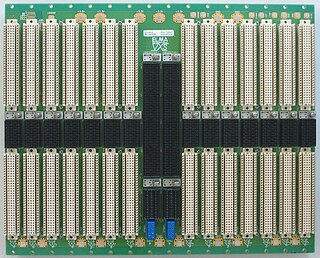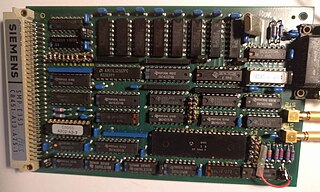
A backplane or backplane system is a group of electrical connectors in parallel with each other, so that each pin of each connector is linked to the same relative pin of all the other connectors, forming a computer bus. It is used to connect several printed circuit boards together to make up a complete computer system. Backplanes commonly use a printed circuit board, but wire-wrapped backplanes have also been used in minicomputers and high-reliability applications.

Eurocard is an IEEE standard format for printed circuit board (PCB) cards that can be plugged together into a standard chassis which, in turn, can be mounted in a 19-inch rack. The chassis consists of a series of slotted card guides on the top and bottom, into which the cards are slid so they stand on end, like books on a shelf. At the spine of each card is one or more connectors which plug into mating connectors on a backplane that closes the rear of the chassis.

VMEbus is a computer bus standard physically based on Eurocard sizes.
A PCI Mezzanine Card or PMC is a printed circuit board assembly manufactured to the IEEE P1386.1 standard. This standard combines the electrical characteristics of the PCI bus with the mechanical dimensions of the Common Mezzanine Card or CMC format.

Electronic test equipment is used to create signals and capture responses from electronic devices under test (DUTs). In this way, the proper operation of the DUT can be proven or faults in the device can be traced. Use of electronic test equipment is essential to any serious work on electronics systems.

PC/104 is a family of embedded computer standards which define both form factors and computer buses by the PC/104 Consortium. Its name derives from the 104 pins on the interboard connector (ISA) in the original PC/104 specification and has been retained in subsequent revisions, despite changes to connectors. PC/104 is intended for specialized environments where a small, rugged computer system is required. The standard is modular, and allows consumers to stack together boards from a variety of COTS manufacturers to produce a customized embedded system.

Multibus is a computer bus standard used in industrial systems. It was developed by Intel Corporation and was adopted as the IEEE 796 bus.

PICMG, or PCI Industrial Computer Manufacturers Group, is a consortium of over 140 companies in the fields of computer science and engineering. Founded in 1994, the group was originally formed to adapt PCI technology for use in high-performance telecommunications, military, and industrial computing applications, but its work has grown to include newer technologies. PICMG currently focuses on developing and implementing specifications and guidelines for open standards–based computer architectures from a wide variety of interconnects.
Advanced Telecommunications Computing Architecture is the largest specification effort in the history of the PCI Industrial Computer Manufacturers Group (PICMG), with more than 100 companies participating. Known as AdvancedTCA, the official specification designation PICMG 3.x was ratified by the PICMG organization in December 2002. AdvancedTCA is targeted primarily to requirements for "carrier grade" communications equipment, but has recently expanded its reach into more ruggedized applications geared toward the military/aerospace industries as well. This series of specifications incorporates the latest trends in high speed interconnect technologies, next-generation processors, and improved Reliability, Availability and Serviceability (RAS).

The STEbus is a non-proprietary, processor-independent, computer bus with 8 data lines and 20 address lines. It was popular for industrial control systems in the late 1980s and early 1990s before the ubiquitous IBM PC dominated this market. STE stands for STandard Eurocard.
Advanced Mezzanine Cards are printed circuit boards (PCBs) that follow a specification of the PCI Industrial Computers Manufacturers Group (PICMG). Known as AdvancedMC or AMC, the official specification designation is AMC.x. Originally AMC was targeted to requirements for carrier grade communications equipment, but later used in other markets.

VPX, also known as VITA 46, is a set of standards for connecting components of a computer, commonly used by defense contractors. Some are ANSI standards such as ANSI/VITA 46.0–2019. VPX provides VMEbus-based systems with support for switched fabrics over a new high speed connector. Defined by the VMEbus International Trade Association (VITA) working group starting in 2003, it was first demonstrated in 2004, and became an ANSI standard in 2007.
M-Modules are a mezzanine standard mainly used in industrial computers. Being mezzanines, they are always plugged on a carrier printed circuit board (PCB) that supports this format. The modules communicate with their carrier over a dedicated bus, and can have all kinds of special functions.
CompactPCI PlusIO is an extension to the PICMG 2.0 CompactPCI industrial standard for modular computer systems. CompactPCI PlusIO was officially adopted by the PCI Industrial Computer Manufacturers Group PICMG as PICMG 2.30 CompactPCI PlusIO in November 2009. Being 100% compatible with CompactPCI, PICMG 2.30 defines a migration path to the future CompactPCI Serial standard. It defines a fixed rear I/O pin assignment that focuses on modern, fast serial point-to-point connections. The new technology succeeding parallel CompactPCI comprises both CompactPCI Serial and CompactPCI PlusIO.
CompactPCI Serial is an industrial standard for modular computer systems. It is based on the established PICMG 2.0 CompactPCI standard, which uses the parallel PCI bus for communication among a system's card components. In contrast to this, CompactPCI Serial uses only serial point-to-point connections. CompactPCI Serial was officially adopted by the PCI Industrial Computer Manufacturers Group PICMG as PICMG CPCI-S.0 CompactPCI Serial in March 2011. Its mechanical concept is based on the proven standards of IEEE 1101-1-1998 and IEEE 1101-10-1996. CompactPCI Serial includes different connectors that permit very high data rates. The new technology standard succeeding parallel CompactPCI comprises another specification called PICMG 2.30 CompactPCI PlusIO. This is why CompactPCI Serial and CompactPCI PlusIO as a whole were also called CompactPCI Plus. PICMG's first working title of CompactPCI Serial was CPLUS.0. CompactPCI Serial backplanes and chassis are developed by Schroff, Elmа, and Pixus Technologies companies, as for the CompactPCI Serial board level electronics – they are developed by MEN Mikro Elektronik, Fastwel, EKF, Emerson Embedded Computing, ADLINK, Data Patterns and Kontron.
PICMG 2.10 is a specification by PICMG that defines the use of the keying mechanisms defined in IEC 1076-4-101 for the J4/P4 connector and in IEEE 1101.10 for handle and cardguide hardware. Backplanes can be designed for 3.3V VIO or 5V VIO operation. These are differentiated by having 'Cadmium Yellow' colored keys for 3.3V or 'Brilliant Blue' color for 5V operation. If the cPCI card operates on a particular VIO voltage the card shall have the respective colored coding key. If the card is compatible with both voltages then it may not have any coding key. Other coding keys exists for use of backplanes and cards that support PICMG 2.5.

Elma Electronic is a publicly traded Swiss electronics company founded in 1960 and based in Wetzikon, Switzerland. The company has 5 product divisions: Systems Platforms, Backplanes, Enclosures & Components, Rotary Switches, and Cabinet Enclosures. The largest segment is systems packaging serving the military, aerospace, homeland security, medical and industrial markets. The Elma Bustronic division develops backplanes, including VME320, which was the world's fastest VME backplane in 1997. Elma Bustronic also develops backplanes in OpenVPX, VMEbus, VME64X, CompactPCI, MicroTCA, and custom bus structures. Elma is an executive member of the PCI Industrial Computer Manufacturers Group (PICMG), VME International Trade Association, and member of the OpenVPX Industry Working Standards Group.

The Europe Card Bus is a computer bus developed in 1977 by the company Kontron, mainly for the 8-bit Zilog Z80, Intel 8080 and Intel 8085 microprocessor families.

Modular crate electronics are a general type of electronics and support infrastructure commonly used for trigger electronics and data acquisition in particle detectors. These types of electronics are common in such detectors because all the electronic pathways are made by discrete physical cables connecting together logic blocks on the fronts of modules. This allows circuits to be designed, built, tested, and deployed very quickly as an experiment is being put together. Then the modules can all be removed and used again when the experiment is done.
MicroTCA is a modular, open standard, created and maintained by the PCI Industrial Computer Manufacturers Group (PICMG). It provides the electrical, mechanical, thermal and management specifications to create a switched fabric computer system, using Advanced Mezzanine Cards (AMC), connected directly to a backplane. MicroTCA is a descendant of the AdvancedTCA standard.











